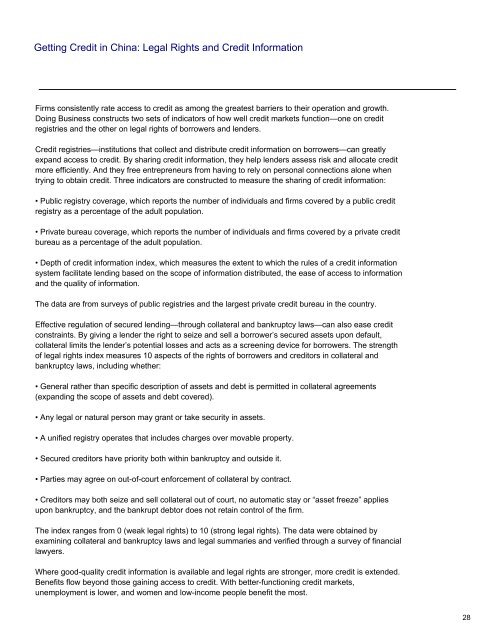View full report - NEEC
View full report - NEEC
View full report - NEEC
- No tags were found...
Create successful ePaper yourself
Turn your PDF publications into a flip-book with our unique Google optimized e-Paper software.
Getting Credit in China: Legal Rights and Credit InformationFirms consistently rate access to credit as among the greatest barriers to their operation and growth.Doing Business constructs two sets of indicators of how well credit markets function—one on creditregistries and the other on legal rights of borrowers and lenders.Credit registries—institutions that collect and distribute credit information on borrowers—can greatlyexpand access to credit. By sharing credit information, they help lenders assess risk and allocate creditmore efficiently. And they free entrepreneurs from having to rely on personal connections alone whentrying to obtain credit. Three indicators are constructed to measure the sharing of credit information:• Public registry coverage, which <strong>report</strong>s the number of individuals and firms covered by a public creditregistry as a percentage of the adult population.• Private bureau coverage, which <strong>report</strong>s the number of individuals and firms covered by a private creditbureau as a percentage of the adult population.• Depth of credit information index, which measures the extent to which the rules of a credit informationsystem facilitate lending based on the scope of information distributed, the ease of access to informationand the quality of information.The data are from surveys of public registries and the largest private credit bureau in the country.Effective regulation of secured lending—through collateral and bankruptcy laws—can also ease creditconstraints. By giving a lender the right to seize and sell a borrower’s secured assets upon default,collateral limits the lender’s potential losses and acts as a screening device for borrowers. The strengthof legal rights index measures 10 aspects of the rights of borrowers and creditors in collateral andbankruptcy laws, including whether:• General rather than specific description of assets and debt is permitted in collateral agreements(expanding the scope of assets and debt covered).• Any legal or natural person may grant or take security in assets.• A unified registry operates that includes charges over movable property.• Secured creditors have priority both within bankruptcy and outside it.• Parties may agree on out-of-court enforcement of collateral by contract.• Creditors may both seize and sell collateral out of court, no automatic stay or “asset freeze” appliesupon bankruptcy, and the bankrupt debtor does not retain control of the firm.The index ranges from 0 (weak legal rights) to 10 (strong legal rights). The data were obtained byexamining collateral and bankruptcy laws and legal summaries and verified through a survey of financiallawyers.Where good-quality credit information is available and legal rights are stronger, more credit is extended.Benefits flow beyond those gaining access to credit. With better-functioning credit markets,unemployment is lower, and women and low-income people benefit the most.28











